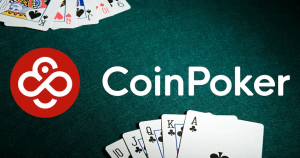Join Our Telegram channel to stay up to date on breaking news coverage
In a significant development for cryptocurrency gamblers, CoinPoker has expanded its payment options to include USDC (USD Coin) alongside its existing USDT (Tether) support. This strategic addition arrives as Tether faces mounting regulatory challenges across multiple jurisdictions.
Key Takeaways
- CoinPoker has added USDC as a payment option alongside USDT
- Tether (USDT) faces regulatory pressure from EU’s MiCA regulations
- Major exchanges including Crypto.com and Kraken are delisting USDT in Europe
- USDC is among 15 stablecoins now fully MiCA-compliant
- The shift represents a growing trend of compliance-focused stablecoin adoption in gambling
The Shifting Stablecoin Market in Gambling
CoinPoker’s integration of USDC reflects a growing recognition of regulatory headwinds facing Tether. The platform’s interface now prominently displays both stablecoin options for deposits, withdrawals, and gameplay, giving users more flexibility in how they manage their crypto gambling funds.
“This addition isn’t simply about offering another payment option,” explains cryptocurrency gambling analyst Maria Reynolds. “It’s a forward-looking move that addresses serious concerns about Tether’s regulatory status and accessibility.”
CoinPoker, established as one of the leading blockchain-based poker platforms, has historically relied heavily on Tether for stable-value transactions. This dependence on USDT has been typical across the crypto gambling sector, where USDT’s liquidity and widespread adoption made it the default stablecoin of choice.
Tether’s Regulatory Challenges
The European Union’s Markets in Crypto-Assets (MiCA) regulation, which took effect December 30, 2024, has created significant compliance hurdles for Tether. The regulation imposes strict requirements for stablecoins operating in the EU, including transparent reserves, regular audits, and consumer protection measures.
As a direct consequence of MiCA implementation:
- Crypto.com will delist USDT by January 31, 2025
- Kraken has announced removal of USDT by March 31, 2025
- Coinbase has already completed its USDT delisting
- The European Securities and Markets Authority (ESMA) has issued guidance on non-compliant stablecoins
These developments follow earlier restrictions in Canada, where regulatory pressure had already limited Tether’s availability. The cumulative effect creates an increasingly fragmented market for USDT, potentially limiting access for players in key regions.
USDC as the Compliant Alternative
Unlike Tether, USDC is among the 15 stablecoins that have achieved MiCA compliance.
Circle, USDC’s issuer, has pursued a proactive regulatory approach, implementing transparent reserve management and regular attestations that satisfy both EU requirements and similar regulations emerging in other jurisdictions.
For crypto gamblers, USDC offers several practical advantages:
- Regulatory stability: Lower risk of sudden exchange delistings or access restrictions
- Multi-chain availability: Supported across multiple blockchain networks including Ethereum, Solana, Avalanche, and Polygon
- Widespread exchange support: Available on virtually all major cryptocurrency exchanges
- Comparable transaction speeds: Performance similar to USDT on the same blockchain networks
“USDC represents the new regulatory-compliant face of stablecoins,” notes blockchain compliance expert Thomas Chen. “Its addition to platforms like CoinPoker indicates a shifting priority toward stability not just in price, but in regulatory standing.”
Implications for Crypto Gambling Operators
For gambling platforms and affiliates, CoinPoker’s move highlights the growing importance of diversifying stablecoin support. Content creators focusing on cryptocurrency gambling face particular considerations:
- Content updates: Existing guides and tutorials mentioning only Tether may need revision to include USDC alternatives
- Regional targeting: Content may require customization based on stablecoin availability in different jurisdictions
- Future-proofing: Anticipating further regulatory developments could inform content strategy
“Platforms that adapt quickly to these regulatory shifts will likely gain competitive advantage,” explains gambling industry consultant Rebecca Langley. “Those that remain exclusively tied to Tether risk disruption to their payment flows and potential customer access issues.”
What Players Should Know
For crypto bettors, CoinPoker’s addition of USDC provides immediate practical benefits:
- Reduced regulatory risk: Less chance of deposit/withdrawal disruptions due to regulatory actions
- Simpler compliance: Easier tax reporting in jurisdictions where USDC is recognized as compliant
- Portfolio diversification: Opportunity to spread risk across multiple stablecoins
- Seamless conversion: Ability to move between USDC and USDT as needed via exchanges
Players should note that transaction fees and speeds will vary depending on the blockchain network used for USDC transactions. Ethereum is typically more expensive but widely supported at most crypto casinos, while alternatives like Solana offer faster and cheaper transactions.
The Future of Stablecoins in Gambling
CoinPoker’s addition of USDC signals a broader industry shift. As regulatory frameworks mature globally, gambling platforms will likely expand beyond USDT to include multiple compliant stablecoin options.
Industry observers anticipate several developments on the horizon:
- More gambling platforms adopting multi-stablecoin approaches
- Integration of bank-issued stablecoins as they enter the market
- Growing importance of geographic-specific stablecoin strategies
- Potential emergence of gambling-specific stablecoins designed for regulatory compliance
“What we’re seeing is just the beginning of a major reconfiguration in how crypto gambling operates,” says digital currency strategist Michael Wong. “The platforms that navigate this transition effectively will be best positioned for long-term growth.”
For now, CoinPoker’s USDC integration represents a pragmatic response to evolving regulatory realities – and a signal to both players and competitors that the stablecoin landscape in gambling is undergoing significant transformation.
Join Our Telegram channel to stay up to date on breaking news coverage


